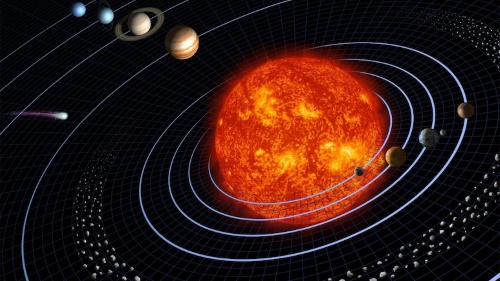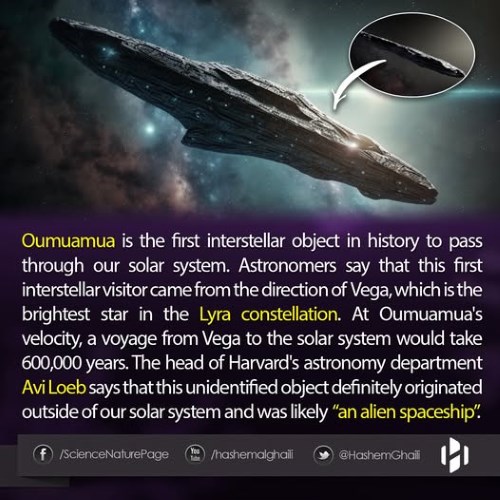A new study suggests that a close encounter with a massive interstellar object, possibly eight times the mass of Jupiter, may have significantly altered the orbits of the four outer planets in our solar system. This encounter, occurring billions of years ago, could explain the slight deviations from ideal circular orbits and the slight tilt observed in their orbital planes.

Source: NASA
Facts about Interstellar objects
Here is detailed information given below:
| Aspect | Details |
| Definition | Objects originating from outside the Solar System that pass through it on hyperbolic paths. |
| Key Features | - Hyperbolic orbits. - Affected by non-gravitational forces like outgassing. |
| Examples | - ʻOumuamua (2017): First Interstellar object which has an unusual shape and unexplained acceleration. - 2I/Borisov (2019): Interstellar comet resembling Solar System comets. |
| Formation | Ejected from distant star systems due to gravitational interactions or planetary formation. |
| Detection Challenges | - Small size, faint brightness, and high velocity. - Limited observation window. |
| Significance | - Insights into other star systems and planetary formation. |
| Future Scope | - Advanced telescopes for better detection. |

Source: ScienceNaturePage
What are the Solar System's Orbital Quirks?
While most models of solar system formation predict perfectly circular and coplanar orbits for the planets, reality presents a slightly different picture.
- Eccentricity: Even Earth's orbit is not perfectly circular, and the outer planets (Jupiter, Saturn, Uranus, and Neptune) exhibit minor deviations from circularity.
- Inclination: The planets do not lie perfectly in the same plane.
The Challenge of Explaining Deviations:
Existing theories, which primarily focus on interactions between the planets themselves, have struggled to fully explain these orbital quirks.
What Role Did an Interstellar Intruder Play in the Encounter of Our Solar System?
The new study proposes a novel explanation: a close encounter with a massive interstellar object.
- Simulation Approach: Using sophisticated computer models, researchers simulated 50,000 flybys of the outer planets by objects ranging from the mass of Jupiter to brown dwarfs.
- Key Parameters: The simulations varied parameters such as the mass, speed, and closest approach distance of the interstellar object.
- Focus on Close Encounters: The study focused on scenarios where the object passed within 20 astronomical units (AU) of the Sun.
What are the outcomes from this Interstellar Object?
The outcomes which appears is :
- Successful Simulations: Approximately 1% of the simulations produced orbital configurations for the outer planets that closely resemble their observed orbits.
- Characteristics of the Intruder:
- Mass: The successful simulations involved objects ranging from 2 to 50 times the mass of Jupiter.
- Closest Approach: Some simulations even included close approaches to Mercury's orbit.
- Impact on Inner Planets: Further simulations including the terrestrial planets (Mercury, Venus, Earth, and Mars) also demonstrated compatibility with the current solar system configuration.
- Most Realistic Scenario: The simulation with the most realistic outcome involved an object eight times the mass of Jupiter passing within 1.69 AU of the Sun, slightly farther than Mars' current orbit.
What are the Implications of this Object?
Implications of this objects are :
- Substellar Objects as Significant Actors: This study highlights the potential significance of encounters with substellar objects (objects more massive than planets but less massive than stars) in shaping the evolution of planetary systems.
- Commonplace Encounters: Given the estimated abundance of substellar objects in the galaxy, encounters with such objects may be more common than previously thought.
This research provides a compelling new perspective on the history of our solar system, suggesting that its current configuration may be a result of a dramatic and unexpected encounter with an interstellar visitor.
Further Research:
According to “Renu Malhotra”, Louise Foucar Marshall Science Research Professor,
Regents Professor of Planetary Sciences,
- "Investigate the potential long-term effects of such encounters on planetary habitability.
- Conduct more detailed simulations to refine the characteristics of the interstellar object and its encounter with the solar system.
- Search for observational evidence of such past encounters in the solar system or other planetary systems."
Comments
All Comments (0)
Join the conversation